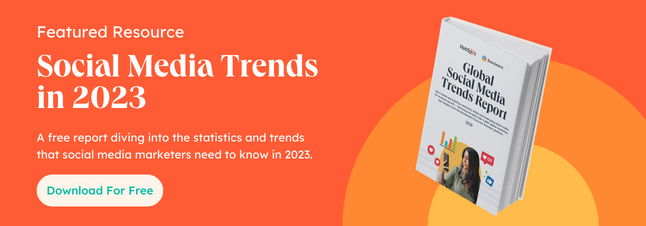![6 Quarantine Trends Here to Stay [Data + Expert Insights] 6 Quarantine Trends Here to Stay [Data + Expert Insights]](https://knowledge.clinicsoftware.com/wp-content/uploads/2022/02/social-media-trends-from-pandemic-1.jpgkeepProtocol.jpeg)
In the beginning of the lockdown, many people have been unable to see household or associates. All social plans have been cancelled — virtually in a single day.
And, within the midst of a lot stress and chaos, many felt extra alone than ever.
Which is why individuals turned to social media in an effort to discover a sense of connection and neighborhood.
Social media grew to become a refuge — a spot to publish genuine, relatable content material and kind relationships nearly when in-person wasn’t an possibility.
And as Lala Fevrier, Wayfair’s Senior Affiliate for Influencer Advertising, places it, “When eating places, colleges, and companies shut down, the one place left with a 24/7 open signal for communication and creativity was social media.”
All of which is to say: Quarantine, and the pandemic at-large, vastly impacted social media. And people modifications have completely shifted customers’ expectations and preferences relating to their social platforms.
Right here, we’ll discover six traits we have seen on account of the pandemic — and why they’re right here to remain.
![Download Now: Social Media Trends in 2022 [Free Report]](https://no-cache.hubspot.com/cta/default/53/3dc1dfd9-2cb4-4498-8c57-19dbb5671820.png)
How The Pandemic Modified Social Media
1. Quarantine elevated time spent on social media, in addition to social customers worldwide.
Between 2019 to 2021, the quantity of social media customers worldwide elevated by 11% — from roughly 3.4 billion in 2019 to three.78 billion in 2021.
As lockdown orders went into impact, many sought out new alternatives to attach with family and friends. Actually, we noticed a 5% leap in international customers from 2019 to 2020 alone.
Folks have been additionally bored, which considerably elevated the time spent on social media apps. Think about, as an illustration, the sudden reputation of bread baking in March, or the random challenges throughout social apps, just like the “flip the change” problem that exploded on TikTok in 2020:
I do know this boredom first-hand: Through the starting of the pandemic, I spent roughly 4 hours every day on Instagram. Quite than grabbing dinner with associates after work or chatting with colleagues on my lunch break, I scrolled by individuals’s IG Tales.
I am not alone. Within the U.S., social media customers jumped from spending 56 minutes per day on social media in 2019 to 65 minutes in 2020 and 2021. And, globally, individuals spent 145 minutes per day on social media in 2020. (It is essential to notice: That quantity has decreased to 142 minutes per day in 2021, suggesting a slight decline in social media use as a number of the world re-opens.)
Social media grew to become a spot to flee the turmoil of the true world. Together with a spike in social media customers, engagement elevated on sure platforms, as effectively. On Instagram, as an illustration, the typical engagement fee for manufacturers elevated by roughly 6% in 2020.
For Sarah White (@thecoastalyogi), a Boston-based health teacher and influencer, the pandemic was a catalyst for her to launch digital choices and leverage social media as a chance to create a robust sense of neighborhood.
White advised me, “Digital choices have been a aspect of my enterprise I had thought of, however had by no means seen a necessity for till March of 2020. Since then, my digital subscriptions have turn into a significant a part of my enterprise and are the first method I work together with my shoppers.”
White provides, “My Instagram is my major supply of selling so my posting has undoubtedly elevated. I’m intentional about answering each message I obtain from shoppers as I do know it is the sort of relationship-building that differentiates a following from a neighborhood.”
2. Quarantine impacted video consumption.
2020 was a formidable yr for video. Actually, media uploads elevated by a staggering 80% year-over-year — peaking at 103,603 video uploads on April 22.
The minutes individuals spent watching movies in 2020 additionally elevated by 85%.
The pandemic vastly impacted how shortly video rose in reputation. It is now the preferred kind of content material, and has been for 2 years in a row.
Moreover, in a HubSpot Weblog survey, 42% of respondents stated “I watch extra movies on social media” in response to the query, “How do you utilize social media otherwise now on account of the pandemic?”

Particularly, TikTok, the favored short-form video platform, noticed exponential progress on account of the pandemic. This may be attributed, largely, to the authenticity of the content material produced on TikTok.
As HubSpot’s Senior Social Media Technique Supervisor Leslie Inexperienced places it, “An enormous platform shift that occurred throughout the pandemic was that tastemakers and tradition shifters have been born on TikTok — not Instagram. TikTok lifted the hyper-filtered veil off of social with short-form, intimate, and genuine video content material.”
Inexperienced provides, “TikTok, largely because of it is For You Web page, grew to become a spot the place anybody might be discovered. And within the final yr many small creators blew up as a result of they have been capable of create content material that spoke poignantly to individuals’s lived experiences and emotions.”
If what you are promoting hasn’t thought of it already, 2022 is an efficient time to check out new kinds of short-form video content material to see the way it resonates along with your viewers.
One other more and more fashionable possibility for video is dwell streaming.
Mari Smith, Premier Fb Advertising Professional (sometimes called the ‘Queen of Fb’) and High Social Media Thought Chief, suggests manufacturers lean extra closely into dwell streaming in 2022.
Smith says, “Embracing dwell streaming — whether or not Fb, Instagram or LinkedIn Reside — can go a good distance in the direction of creating extra intimate relationships along with your followers. Consider your dwell movies as ‘mini webinars’ and all the time attempt so as to add nuggets of invaluable, academic (and/or entertaining!) content material, earlier than including your call-to-action.”
In 2022, take into account testing completely different platforms and content material varieties — resembling TikToks, Instagram Tales, YouTube movies, or Fb dwell streams — to search out out which video format performs greatest along with your viewers.
3. The pandemic impacted one of the best occasions to publish on social.
These days, many individuals make money working from home and have chosen distant work as their most well-liked way of life transferring ahead.
Suffice to say, the pandemic completely shifted individuals’s work schedules.
And, as the everyday 9-to-5 work hours modified on account of the pandemic, social media peak hours adjusted, too.
As an illustration, Sprout Social discovered the brand new greatest occasions to publish on Facbook are Monday, Wednesday, and Friday from 10–11 a.m.; Monday, Tuesday and Friday at 11 a.m. and Tuesday at 2 p.m. are one of the best occasions to publish on Instagram.
And at present, one of the best occasions to publish on LinkedIn are Wednesday at 3 p.m, Thursday at 9–10 a.m., and Friday from 11 a.m.-noon.
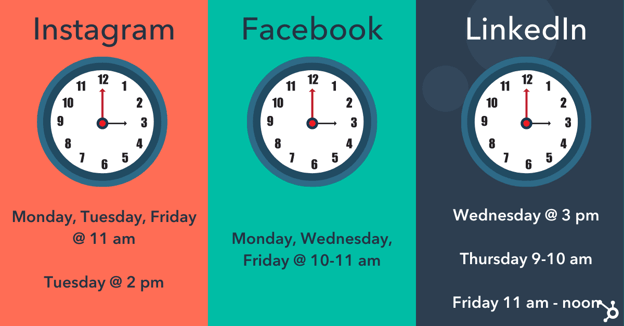
It is essential to contemplate how the pandemic modified the best way individuals work, and when. As an illustration, now that I am working from house, I take a daily social media break daily round 10 a.m. whereas I eat my breakfast, since I haven’t got colleagues round to speak with.
In 2022, you may wish to conduct your personal checks to find out which occasions are hottest with your viewers — and on which channels.
4. The pandemic impacted the preferred kinds of content material.
Through the stress and uncertainty of quarantine and the start of the pandemic, many turned to social media to flee the true world. Which is why enjoyable, lighthearted kinds of content material gained out.
Actually, in 2020, roughly half (42%) of Gen Zers stated they wished content material described as enjoyable — which surpassed Gen Zers’ curiosity in romantic content material (29%) and thrilling content material (27%).
As boredom on account of quarantining ensued, social media customers wished shiny, playful, light-hearted content material to cheer them up.
Even now, two years later, 34% of HubSpot Weblog Survey respondents stated they nonetheless hunt down extra constructive and uplifting content material than they did pre-pandemic.
Together with extra colourful, lighthearted content material, we additionally noticed a rise in genuine, user-generated content material in 2020. Between March and April, throughout peak lockdown interval, a Lightricks research discovered People spent over 90% extra time utilizing apps to create and edit photos, movies, and visible content material.
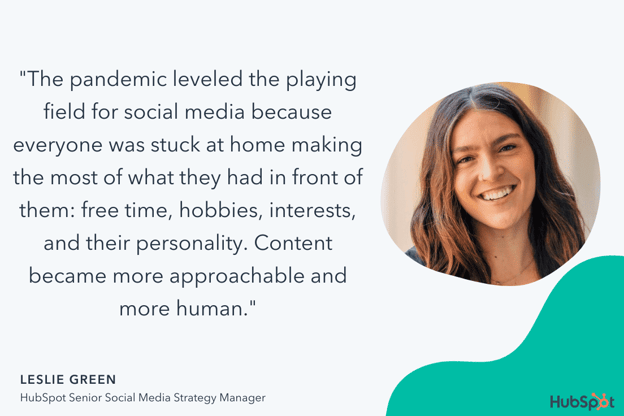
Inexperienced says, “The pandemic leveled the taking part in discipline for social media as a result of everybody was caught at house profiting from what they’d in entrance of them: free time, hobbies, pursuits, and their persona. Content material grew to become extra approachable and extra human. Each day customers created posts that spoke to actual lived experiences fairly than a curated picture.”
Neal Schaffer, Digital & Social Media Advertising Marketing consultant, Speaker, and Creator, agrees that the pandemic shifted the kinds of content material that carry out greatest.
He says, “One main impression that COVID had on social media was in conserving content material actual. Once we could not exit for picture shoots, it required celebrities to show their houses into studios and influencers to publish extra of their uncooked selves.”
Schaffer says, “As human beings, we sought out individuals who have been having related experiences to us … This made social media content material extra uncooked, plausible, and genuine — and, because of this, additional democratized content material creation by reducing the brink of what was required to create content material.”
Schaffer provides, “Mix this with the recognition of short-form video, and an entire new technology of content material creators was born.”
I would argue we’re all higher off in a world through which social media customers publish genuine, non-filtered photos to depict the realities of life. These #actual posts assist audiences really feel much less alone, and may foster a a lot stronger sense of neighborhood.
Which is why it is vital your staff focuses on creating extra genuine, behind-the-scenes content material in 2022. Actually, a lot of you already plan to — HubSpot’s Weblog Analysis discovered 79% of B2B and 54% of B2C plan on rising investments in genuine/behind the scenes content material in 2022.
5. Quarantine sped up influencer advertising’s reputation.
Influencer advertising grew exponentially on account of the pandemic.
The influencer advertising trade went from $1.7 billion in 2016 to $9.7 billion in 2020 — a staggering 470% enhance — and is predicted to leap to $13.8 billion in 2021.
I spoke with Jesse Leimgruber, CEO of influencer advertising company NeoReach, to study his perspective on how the pandemic impacted the influencer advertising trade.
Leimgruber advised me, “The pandemic boosted the creator economic system into the highlight. Hundreds of thousands of recent creators joined the scene, and lots of discovered new methods to earn and help their craft. This additional consideration on social media allowed influencers to earn cash and switch a passion right into a occupation.”
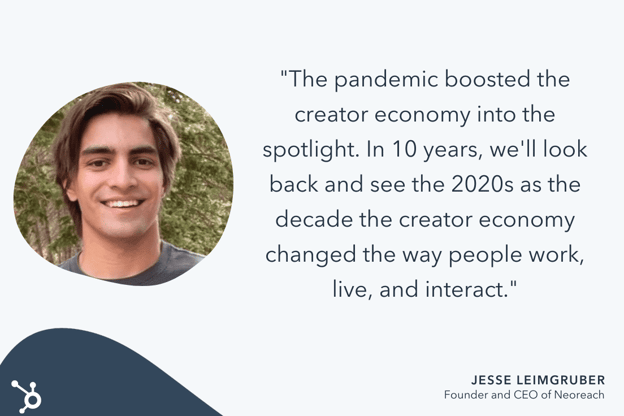
He provides, “Sponsored posts, partnerships, merch gross sales and fan donations have proliferated within the final two years. Enterprise {dollars} into the creator economic system are at an all-time excessive, and public curiosity within the house is simply getting began. In 10 years, we’ll look again and see the 2020s as the last decade the creator economic system modified the best way individuals work, dwell, and work together.”
In the beginning of quarantine, we noticed manufacturers draw back from influencer advertising because the economic system grew to become extra unsure and unstable. This is sensible: As a comparatively new type of advertising, influencer advertising can seem to be a riskier funding to groups struggling to remain afloat.
Nevertheless, because the world adjusted to lockdowns and distant work, influencer advertising started rising once more in reputation. Influencer campaigns elevated by 37% between Q2 and Q3 of 2020, and rose by an extra 34% between Q3 and This fall.
And influencer advertising’s reputation is not slowing down. In 2021, sponsored content material elevated by nearly 27%.
Wayfair’s Lala Fevrier agrees that the creator economic system has skyrocketed — and, she provides, this creator economic system is basically made up of Gen Z influencers.
Fevrier says, “The most important group to make the most of social media’s accessibility is Gen Z influencers. Due to their efforts, manufacturers are beginning to understand they needn’t spend thousands and thousands of {dollars} producing content material and adverts that in any other case really feel disingenuous at occasions. There’s a community of people telling wonderful tales about their favourite manufacturers or merchandise simply because they love them.”
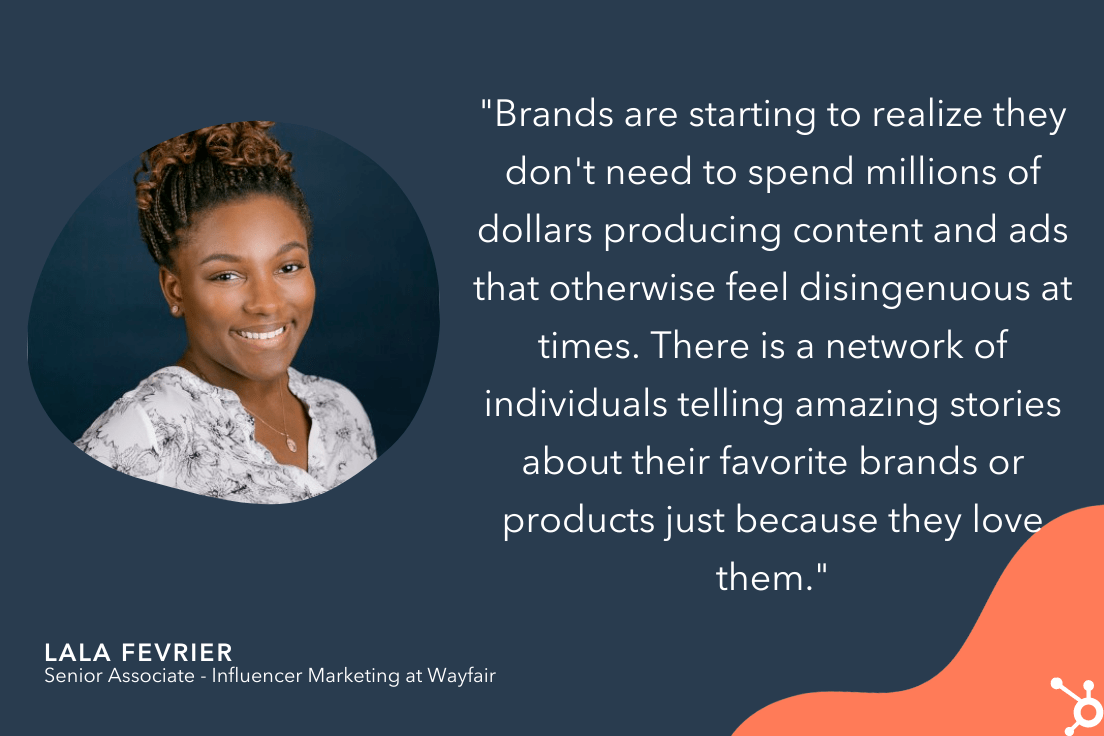
If you happen to’re all in favour of getting began with influencer advertising, take into account the facility of micro-influencers to have interaction instantly along with your meant viewers and see extra ROI than you would possibly with an even bigger superstar. HubSpot’s Weblog Analysis surveyed entrepreneurs who already work with influencers, and located 67% of them work with micro-influencers (10K-100K followers/subscribers), adopted by 58% who work with macro-influencers (100K-1M followers/subscribers).
6. The pandemic elevated the necessity for neighborhood — and new platforms are rising, because of this.
Being caught at handmade it troublesome — if not unimaginable — to really feel a way of neighborhood.
Pre-pandemic, many individuals turned to the workplace, health courses, parks, or different public areas to really feel linked to a bigger group.
In a single day, these have been not an possibility.
Thankfully, when used accurately, social media can fill within the gaps and assist serve the elemental human want of connection.
As Mari Smith advised me: “You completely can’t beat the facility of constructing a fiercely loyal neighborhood the place members bond with each other — and with you.”
Smith provides, “Definitely, [community] might be cultivated over time by a Fb Group linked to your Fb Web page. Nevertheless, neighborhood platforms are on the rise as customers and leaders alike hunt down completely different platforms on which to construct and be part of tribes.”
Smith says, “I surveyed my Fb viewers in October final yr on this subject. Each Mighty Networks and Circle are rising in reputation by way of a substitute for Fb Teams. I predict we’ll see a slight rise this yr in neighborhood leaders selecting emigrate away from Fb in the direction of one in all these different platforms with a purpose to cater to their tribe members who’ve misplaced belief in Fb.”
Fb Teams continues to be a viable possibility for making a stronger sense of neighborhood and constructing relationships along with your prospects and clients, however in 2022, you may see manufacturers experiment with different community-building platforms.
In 2021, social media grew to become the #1 channel utilized in advertising. It is vital you learn to pivot with these traits to proceed to see progress and success throughout platforms.
The excellent news? Social media customers are craving authenticity now greater than ever. So the extra your model can lean into its personal uniqueness, the higher.
